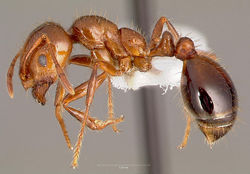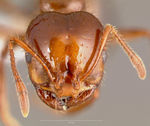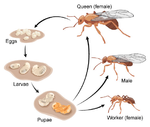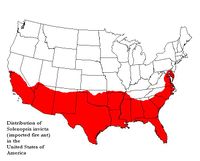Red imported fire ant
| Red imported fire ant |
|---|

|
| Scientific Classification |
|
| Scientific Name |
|
Solenopsis Invicta |
The Red imported fire ant, also known as RIFA is one of the worst type of ants in the world. Scientists say it disturbs many native species because it can reproduce quickly, eat almost anything, and the queen can fly away and start a new colony if needed. The RIFA has also affected many homes and businesses because it can tamper with the electrical system of the building. [2]
The RIFAs are the worst types of ants because they can, swarm any intruder quickly, and have very painful stings and bites.[3]It is also one of the most aggressive ant species. Most ants have a really specific type of food they eat. The RIFA can also grab each other and make a raft to survive floods. If the RIFA does not have the safety of a nest they will sting with more venom than usual.[4]They may have more than one queen in their nests at a time, and each queen may lay up to 200 eggs each day! Most colonies consist of one million worker ants.[5]
Body Design
The red imported fire ants are between 1/16 to 1/5 inch long, and are a dark reddish brown on the head and thorax. They also have three body segments: head, body, and thorax. The thorax contains tightly packed muscles.[6]It has two nodes between the abdomen and the thorax. They have a bent antennae, with 10 segments on each antennae.[7]The RIFA has compound eyes for detecting movement and light, two strong mandibles for biting, cutting, digging and carrying. They have a mouth for cleaning and eating, and have two sensitive antennae for touching, tasting, smelling and communication. They also have six legs that have sharp claws at the end of them. Their abdomen is connected to the thorax by a flexible joint that has a stinger on the tip. The abdomen of the RIFA contains the heart, digestive system, and the venom sac.[8]
Life Cycle
The life cycle of the Red Imported Fire Ants, Solenopsis Invicta, are similar to other ants. Complete metamorphosis occurs as the egg, larva, pupa, and adult are involved.[9] The males and females that reproduce have wings and mate in mid-air when temperature conditions are 75-90 degrees Fahrenheit. Shortly after mating, the males die.[10] The ant queen lays about 10-15 eggs to start a colony. Once hatched, the queen feeds them and a mound starts to appear when the colony grows. This takes several months.[11] There may be more than 1 queen per colony and she may live up to 7 years laying 1000-1500 eggs per day.[12] Some colonies only have one queen while others have multiple. There could be 100 queens in 1 colony. If the queens die, the colony can no longer survive. After the ant hatches, it takes about a month to fully develop.[13]
Ecology
The red imported fire ant has the ability to adapt to different types of situations, such as flooding and drought conditions. During flooding or drought conditions, these ants can save themselves by gathering themselves together to form a giant pile. Then they form a floating raft with their bodies. They are incredibly light and small that if one ant sinks, it can lift itself up through the air bubbles rising from underneath. These rafts are extremely dangerous during these conditions because they are constantly fighting for their lives. They become more aggressive and require higher doses of venom than usual. [14].These fire ants have an incredibly huge population within their colonies. Each fire ant colony can have up to 100,000 to 500,000 ants. However, the queen can produce and lay about 1500 to 5000 eggs per day. Due to the queens' position, it never leaves the nest and can live longer than other ants. The fire ants revolve around the queen, whom they take care of, and her eggs. The fire ants duties are to protect the queen and the colony, keep on increasing the durability of the nest and collect food. There is only a queen because when the female and male mate, the male dies and the queen continues to live and eventually start her new colony.[15]
Invasive Species
Location and Method of Introduction The infamous red imported fire ant was introduced into the United States from Brazil in the 1940's.[16] It continued to spread across the southern part of the United States. It has invaded fourteen states, such as Alabama, California , Florida, etc. It has also spread to other countries outside the United States. Taiwan, Eastern Australia and China has also been the victims of these ants. New Zealand managed to eliminate these ants before they continued to spread.[17] These red imported fire ants have seasonal mating flights which occur mostly in the spring or early summer. These mating flights cause these ants to spread naturally. Due to the tiny size these ants possess, they are able float downstream or on debris and wastes during floods. These ants can also be spread by man. They, usually the females, are attracted to vehicles with shiny reflections. This causes them to attach, and sometimes settle under cars and trucks in large cliques. [16]
Environmental Impact
These fire ants can do damage beyond our expectations. When mounds are formed by fire ants on public property, such as lawns and sporting fields, they can cause a major problem. From their constant daily activities, they can cause damage costing thousands of dollars.[18]Their physical damage towards humans alone is substantial. They are known for their sting that can leave an extensive scar on the skin.[19] Fire ants feed on spiders, lizards, frogs, and even birds or mammals. Through time they may replace or eliminate the native species of the country.[18] This is why red imported fire ants are an invasive species that, if not controlled, may damage the environment substantially.
Control Methods
Controlling these red important fire ants require chemicals to fully eliminate these ants. Non chemical methods are not so effective when trying to control them. Digging the mounds can result in the ants dispersing everywhere and building new nests. The most effective method that is non chemical, so far, is pouring boiling water[16] or flammable liquids directly into the individual nests, but this is not recommended because it can harm the environment and humans.[14].This method unfortunately eliminates the ants and the nests only 60% of the time. Using chemicals like liquid insecticides to drown the individual pathways inside the nests can eliminate more than using boiling water alone.[16] One of the most effective methods scientists have found is using bait. Baits are easy and more effective than drenching the mounds. Common baits used include growth regulator baits, and boric acid/sucrose water baits. The baits are poured over the individual ant mounds, then they are consumed by the ants. The most important objective is to eliminate and kill the queen ant, disrupting the entire colony.[14]
Video
Learn about the Red Imported Fire Ant (RIFA) with this short, informational video
References
- ↑ [1] Wikispecies. Web. Last Modified on March 16, 2016. Unknown Author.
- ↑ . Intro [2] November 2 2016 Author unknown.October 25, 2016.
- ↑ [3] July 27, 2016 Author unknown.
- ↑ http://www.pestworld.org/news-hub/pest-articles/red-imported-fire-ants-101/,June 11 2016 Author unknown.
- ↑ [4] August 20 2016 Author unknown.
- ↑ Greenberg, L Red Imported Fire Ant, Last accessed on October 29, 2016.
- ↑ Head [5] June 21, 2016. Unknown Author.
- ↑ Head as well [6] Unknown Author
- ↑ [7] Orkin. Web. Last accessed on October 30, 2016. Unknown Author
- ↑ [8] Extension. Web. Last accessed on October 30, 2016. Unknown Author
- ↑ Collins, Laura and Scheffrahn Rudolf [9] University of Florida. Web. last accessed on October 10, 2016.
- ↑ [10] Light Span. Web. last accessed on October 30, 2016. Unknown Author
- ↑ Greenberg, L[11] UC Cooperative Extension. Web. Last accessed on October 30, 2016
- ↑ 14.0 14.1 14.2 Red imported fire ant Wikipedia.Web. Last updated on October 25, 2016. Unknown Author
- ↑ Red Imported Fire Ant Desert Museum. Web. Last accessed on November 2, 2016. Unknown Author.
- ↑ 16.0 16.1 16.2 16.3 RIFA Entoweb. Web. Last accessed on October 29, 2016. Unknown Author
- ↑ Geographic DIstribution Extension. Web. Published on September 28, 2016. Unknown Author
- ↑ 18.0 18.1 Fire Ant Impacts Queensland Government. Web. Last updated on July 1st, 2016. Unknown Author
- ↑ Les Greenberg and John Klotz. The Red Imported Fire Ants UC Rverside. Web. Last accessed on October 29,2016.




